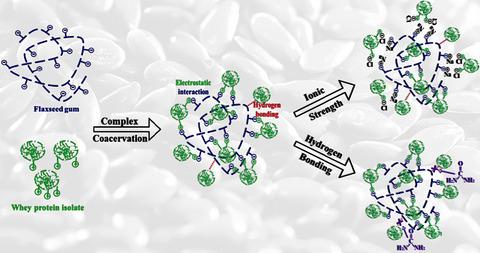当前位置:
X-MOL 学术
›
Food Sci. Nutr.
›
论文详情
Our official English website, www.x-mol.net, welcomes your
feedback! (Note: you will need to create a separate account there.)
Ionic strength and hydrogen bonding effects on whey protein isolate-flaxseed gum coacervate rheology.
Food Science & Nutrition ( IF 3.5 ) Pub Date : 2020-03-10 , DOI: 10.1002/fsn3.1504 Jun Liu 1, 2 , Youn Young Shim 2, 3, 4, 5 , Martin J T Reaney 2, 3, 4
Food Science & Nutrition ( IF 3.5 ) Pub Date : 2020-03-10 , DOI: 10.1002/fsn3.1504 Jun Liu 1, 2 , Youn Young Shim 2, 3, 4, 5 , Martin J T Reaney 2, 3, 4
Affiliation

|
Whey protein isolate (WPI) was mixed with anionic flaxseed (Linum usitatissimum L.) gum (FG), and phase transition during coacervate formation was monitored. Effects of ionic strength and hydrogen bonding on coacervation of WPI‐FG system and corresponding rheological properties were investigated. During coacervate formation, structural transitions were confirmed by both turbidimetry and confocal laser scanning microscopy. Increasing ionic strength with sodium chloride (50 mM) decreased optical density (600 nm) at pHmax. Correspondingly, pHc and pHϕ1 decreased from pH 5.4 to 4.8 and from 5.0 to 4.6, respectively, while pHϕ2 increased from pH 1.8 to 2.4. Sodium chloride suppressed biopolymer electrostatic interactions and reduced coacervate formation. Adding urea (100 mM) shifted pHϕ1, pHmax, and pHϕ2 from 4.8, 3.8, and 1.8 to 5.0, 4.0, and 2.2, respectively, while pHc was unaffected. Optical density (600 nm) at pHmax (0.536) was lower than that of control in the absence of urea (0.617). This confirmed the role of hydrogen bonding during coacervate formation in the biopolymer system composed of WPI and FG. Dynamic shear behavior and viscoelasticity of collected coacervates were measured, and both shear‐thinning behavior and gel‐like properties were observed. Addition of sodium chloride and urea reduced ionic strength and hydrogen bonding, resulting in decreased WPI‐FG coacervate dynamic viscosity and viscoelasticity. The disturbed charge balance contributed to a loosely packed structure of coacervates which were less affected by altered hydrogen bonding. Findings obtained here will help to predict flaxseed gum behavior in protein‐based foods.
中文翻译:

离子强度和氢键对乳清分离蛋白-亚麻籽胶凝聚层流变学的影响。
将乳清分离蛋白 (WPI) 与阴离子亚麻籽 ( Linum usitatissimum L.) 胶 (FG) 混合,并监测凝聚层形成过程中的相变。研究了离子强度和氢键对WPI-FG体系凝聚和相应流变性能的影响。在凝聚层形成过程中,通过比浊法和共焦激光扫描显微镜证实了结构转变。用氯化钠 (50 mM) 增加离子强度,降低 pH max时的光密度 (600 nm)。相应地,pH c和 pH φ1分别从 pH 5.4 下降至 4.8 和从 5.0 下降至 4.6,而 pH φ2从 pH 1.8 上升至 2.4。氯化钠抑制生物聚合物静电相互作用并减少凝聚层形成。添加尿素 (100 mM) 使 pH φ1 、pH max和 pH φ2从 4.8、3.8 和 1.8 分别变为 5.0、4.0 和 2.2,而 pH c不受影响。 pH最大值(0.536) 时的光密度 (600 nm) 低于不含尿素的对照 (0.617)。这证实了在由WPI和FG组成的生物聚合物系统中凝聚层形成过程中氢键的作用。测量了收集的凝聚层的动态剪切行为和粘弹性,并观察到剪切稀化行为和凝胶状特性。添加氯化钠和尿素降低了离子强度和氢键,导致 WPI-FG 凝聚层动态粘度和粘弹性降低。电荷平衡的紊乱导致凝聚层结构松散,受氢键改变的影响较小。 这里获得的研究结果将有助于预测亚麻籽胶在蛋白质食品中的行为。
更新日期:2020-03-10
中文翻译:

离子强度和氢键对乳清分离蛋白-亚麻籽胶凝聚层流变学的影响。
将乳清分离蛋白 (WPI) 与阴离子亚麻籽 ( Linum usitatissimum L.) 胶 (FG) 混合,并监测凝聚层形成过程中的相变。研究了离子强度和氢键对WPI-FG体系凝聚和相应流变性能的影响。在凝聚层形成过程中,通过比浊法和共焦激光扫描显微镜证实了结构转变。用氯化钠 (50 mM) 增加离子强度,降低 pH max时的光密度 (600 nm)。相应地,pH c和 pH φ1分别从 pH 5.4 下降至 4.8 和从 5.0 下降至 4.6,而 pH φ2从 pH 1.8 上升至 2.4。氯化钠抑制生物聚合物静电相互作用并减少凝聚层形成。添加尿素 (100 mM) 使 pH φ1 、pH max和 pH φ2从 4.8、3.8 和 1.8 分别变为 5.0、4.0 和 2.2,而 pH c不受影响。 pH最大值(0.536) 时的光密度 (600 nm) 低于不含尿素的对照 (0.617)。这证实了在由WPI和FG组成的生物聚合物系统中凝聚层形成过程中氢键的作用。测量了收集的凝聚层的动态剪切行为和粘弹性,并观察到剪切稀化行为和凝胶状特性。添加氯化钠和尿素降低了离子强度和氢键,导致 WPI-FG 凝聚层动态粘度和粘弹性降低。电荷平衡的紊乱导致凝聚层结构松散,受氢键改变的影响较小。 这里获得的研究结果将有助于预测亚麻籽胶在蛋白质食品中的行为。











































 京公网安备 11010802027423号
京公网安备 11010802027423号